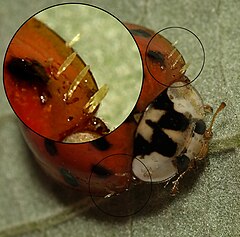Laboulbeniales
 From Wikipedia the free encyclopedia
From Wikipedia the free encyclopedia
| Laboulbeniales | |
|---|---|
 | |
| Hesperomyces virescens on Harmonia axyridis | |
| Scientific classification | |
| Kingdom: | |
| Division: | |
| Class: | |
| Order: | Laboulbeniales Engler (1898) |
| Families | |
The Laboulbeniales is an order of Fungi within the class Laboulbeniomycetes. They are also known by the colloquial name beetle hangers[1] or labouls. The order includes around 2,325 species[2] of obligate insect ectoparasites that produce cellular thalli from two-celled ascospores. Of the described Laboulbeniales, Weir and Hammond 1997 find 80% to be from Coleoptera and the next largest group to be the 10% from Diptera.[3] Recently, the genus Herpomyces, traditionally considered a basal member of Laboulbeniales, was transferred to the order Herpomycetales based on molecular phylogenetic data.[4][5] Laboulbeniales typically do not kill their hosts, although they may impair host fitness if the parasite density is high.
Laboulbeniales form individual thalli, and lack vegetative hyphae. A thallus is attached to its host by a simple dark-colored foot cell, or a rhizoidal haustorium through which the fungus penetrates the exoskeleton of its host to draw nutrients from the hemolymph.[6] The external part of the thallus may form male structures (antheridia) or female structures (trichogynes and perithecia), or both. New infections are initiated when spores from the perithecia attach to a compatible insect host. Spore transmission can sometimes occur during insect copulation, which may account for the different site specificity sometimes observed in male and female hosts. These fungi do not grow apart from their hosts.
Foundational work on the Laboulbeniales was completed by the American mycologist Roland Thaxter (1858–1932), particularly in his five-volume, illustrated Monograph of the Laboulbeniaceae (Thaxter 1896, 1908, 1924, 1926, 1931).
Recent molecular phylogenetic work has shown that some taxa are complexes of multiple species segregated by host, for example Hesperomyces virescens.[7] The classification of the order Laboulbeniales follows Isabelle Tavares (1985) but several taxa in that system are polyphyletic.[8][9]
References[edit]
- ^ Cooke MC (1892). Vegetable wasps and plant worms : a popular history of entomogenous fungi, or fungi parasitic upon insects /. London: Society for Promoting Christian Knowledge. doi:10.5962/bhl.title.34922.
{{cite book}}:|work=ignored (help) - ^ Kirk, Paul (2019). "Catalogue of Life".
- ^ Haelewaters, Danny; Blackwell, Meredith; Pfister, Donald H. (2021-01-07). "Laboulbeniomycetes: Intimate Fungal Associates of Arthropods". Annual Review of Entomology. 66 (1). Annual Reviews: 257–276. doi:10.1146/annurev-ento-013020-013553. ISSN 0066-4170. PMID 32867528. S2CID 221403779.
- ^ Haelewaters, Danny; Pfliegler, Walter P.; Gorczak, Michał; Pfister, Donald H. (2019). "Birth of an order: Comprehensive molecular phylogenetic study excludes Herpomyces (Fungi, Laboulbeniomycetes) from Laboulbeniales". Molecular Phylogenetics and Evolution. 133: 286–301. doi:10.1016/j.ympev.2019.01.007. hdl:2437/262843. PMID 30625361. S2CID 58645110.
- ^ Blackwell, Meredith; Haelewaters, Danny; Pfister, Donald H. (2020). "Laboulbeniomycetes: Evolution, natural history, and Thaxter's final word". Mycologia. 112 (6): 1048–1059. doi:10.1080/00275514.2020.1718442. ISSN 0027-5514. PMID 32182189. S2CID 212750948.
- ^ Tragust, Simon; Tartally, András; Espadaler, Xavier; Santamaria, Sergi (2016). "Histopathology of Laboulbeniales (Ascomycota: Laboulbeniales): ectoparasitic fungi on ants (Hymenoptera: Formicidae)". Myrmecological News. 23: 81–89.
- ^ Haelewaters D, De Kesel A, Pfister DH (2018). "Integrative taxonomy reveals hidden species within a common fungal parasite of ladybirds". Scientific Reports. 8 (1): 15966. Bibcode:2018NatSR...815966H. doi:10.1038/s41598-018-34319-5. PMC 6206035. PMID 30374135.
- ^ Goldmann L, Weir A (2018). "Molecular phylogeny of the Laboulbeniomycetes (Ascomycota)". Fungal Biology. 122 (2–3): 87–100. doi:10.1016/j.funbio.2017.11.004. PMID 29458722.
- ^ Haelewaters D, Page RA, Pfister DH (2018). "Laboulbeniales hyperparasites (Fungi, Ascomycota) of bat flies: Independent origins and host associations". Ecology and Evolution. 8 (16): 8396–8418. doi:10.1002/ece3.4359. PMC 6145224. PMID 30250711.
Further reading[edit]
- Alexopolous CJ, Mims CW, Blackwell M (2004). Introductory Mycology (4th ed.). Hoboken NJ: John Wiley and Sons. ISBN 0-471-52229-5.
- Thaxter R (1896). "Contribution towards a monograph of the Laboulbeniaceae. I.". Memoirs of the American Academy of Arts and Sciences. 12: 187–429.
- Thaxter R (1908). "Contribution towards a monograph of the Laboulbeniaceae. II". Memoirs of the American Academy of Arts and Sciences. 13 (6): 217–469. doi:10.2307/25058090. JSTOR 25058090.
- Thaxter R (1924). "Contribution towards a monograph of the Laboulbeniaceae. III". Memoirs of the American Academy of Arts and Sciences. 14 (5): 309–426. Bibcode:1924MAAAS..14..313T. doi:10.2307/25058114. hdl:2027/coo.31924051820953. JSTOR 25058114.
- Thaxter R (1926). "Contribution towards a monograph of the Laboulbeniaceae. IV". Memoirs of the American Academy of Arts and Sciences. 15 (4): 427–580. doi:10.2307/25058132. JSTOR 25058132.
- Thaxter R (1931). "Contribution towards a monograph of the Laboulbeniaceae. V.". Memoirs of the American Academy of Arts and Sciences. 16: 1–435. doi:10.2307/25058136. JSTOR 25058136.
External links[edit]
 Media related to Laboulbeniales at Wikimedia Commons
Media related to Laboulbeniales at Wikimedia Commons- Bugguide.net. Harmonia axyridis with Laboulbeniales fungus
- Article about Laboulbeniales on Diptera by Jan Máca
- Laboulbeniales homepage by Dr. Alex Weir